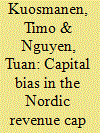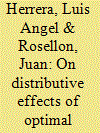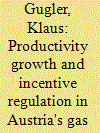|
|
|
Sort Order |
|
|
|
Items / Page
|
|
|
|
|
|
|
| Srl | Item |
| 1 |
ID:
176667


|
|
|
|
|
| Summary/Abstract |
Nordic energy market reform and the regulation of local monopolies in electricity transmission and distribution sectors have served as role models for many other countries worldwide. The first contribution of this paper is to clarify the conceptual distinction between the Nordic revenue cap approach and the British revenue cap regulation. Our second contribution is to show that the Nordic revenue cap is similar to the U.S.-style rate of return regulation in that both are subject to capital bias, known as the Averch-Johnson effect. The third contribution of this paper is to examine the magnitude of the capital bias and its welfare effects by means of numerical simulations. We show that the Nordic revenue cap generally decreases the monopoly profit, increases the output, decreases the price, and hence increases consumer surplus compared to the unregulated monopoly. The simulation results prove robust to changes in the parameter values and the functional form of the production function. Our numerical simulations reveal that relatively light handed regulation suffices to yield the main benefits.
|
|
|
|
|
|
|
|
|
|
|
|
|
|
|
|
| 2 |
ID:
121386


|
|
|
|
|
| Publication |
2013.
|
| Summary/Abstract |
For a long time considered as technologically mature, electric systems are now facing a period of rapid evolution, inspired by climate change concerns. Several studies show that current regulation of natural monopolies does not offer sufficient incentives for network operators (and network users) to participate in this process.
Taking Italy as a case study, this paper analyses how energy regulation can change to support the current transformation. We describe the recent regulatory interventions in the domain of smart grids, smart metering and electromobility, with a specific emphasis on the provisions aimed at fostering innovation-an issue that until recently has received almost no attention in the literature nor in the practice of regulation.
The progress we observe is considerable in all new areas of concern, and, above all, in the regulator's commitment to provide the right incentives for investments in demonstration projects: the acquisition of experience is regarded as essential to move to more sophisticated regulatory instruments. Finally, regulation is also increasingly concerned with network users, both traditional and new, with the objective to stimulate more active behaviours.
|
|
|
|
|
|
|
|
|
|
|
|
|
|
|
|
| 3 |
ID:
171523


|
|
|
|
|
| Summary/Abstract |
The transition from a short-term cost-plus tariff regulation to either a long-term rate-of-return or long-term price cap regulation in Russia started in 2009 and was completed in 2012, causing substantial changes in investment over the course of the reform. We estimate panel data of 46 Russian electricity distribution entities with a dynamic investment model using the system generalized method of moments and addressing potential endogeneity issues. We show that, despite the noncredible regulatory policy, the transition from short-to long-term regulation had a positive and significant effect on the investment rate of regulated entities. The specific long-term regulation design applied in Russia from 2008 to 2017 (either rate-of-return or price cap) had no effect on the investment rate. These results are important for the introduction of changes in regulatory frameworks in developing countries.
|
|
|
|
|
|
|
|
|
|
|
|
|
|
|
|
| 4 |
ID:
092862


|
|
|
|
|
| Publication |
2009.
|
| Summary/Abstract |
Incentive regulation for networks has been an important part of the reform agenda in a number of countries. As part of this regulatory process, incentives are put in place to improve the cost efficiency of network companies by rewarding good performance relative to a pre-defined benchmark. The techniques used to establish benchmarks are central to the efficiency improvements that are ultimately achieved. Much experience has been gained internationally in the application of benchmarking techniques and we now have a solid understanding of the main indicators of best practice. What we are lacking is a more complete understanding of the factors that influence choice of methods by regulators. In this paper, we present the results of an international survey of energy regulators in 40 countries conducted electronically between June and October 2008. Regulators from European, Australasian and Latin American countries are represented in the survey. Our results show that benchmarking techniques are now widespread in the regulation of gas and electricity networks. Best practice, however, is limited to a small number of regulators. We conclude by summarising existing trends and offering some recommendations on overcoming barriers to best practice efficiency analysis.
|
|
|
|
|
|
|
|
|
|
|
|
|
|
|
|
| 5 |
ID:
132654


|
|
|
|
|
| Publication |
2014.
|
| Summary/Abstract |
To date, the distributive implications of incentive regulation on electricity transmission networks have not been explicitly studied in the literature. More specifically, the parameters that a regulator might use to achieve distributive efficiency under price-cap regulation have not yet been identified. To discern these parameters is the motivation for the research presented in this paper. We study how different weight parameters affect the distributive characteristics of optimal price-cap incentive regulation for electricity transmission. We find that a regulator×s use of ideal (Laspeyres) weights tends to be more beneficial for the Transco (consumers) than for consumers (the Transco).
|
|
|
|
|
|
|
|
|
|
|
|
|
|
|
|
| 6 |
ID:
169750


|
|
|
|
|
| Summary/Abstract |
The projected rate of productivity growth is the critical determinant of the price cap in incentive regulation. However, the regulatory authorities generally lack sophisticated industry TFP studies to set an optimal cap. We thus estimate productivity growth in the Austrian gas distribution sector in a translog cost function framework. A key feature is our unique panel database on costs and outputs of regulated utilities for the period 2002–2013, covering six years prior and during incentive regulation as introduced in 2008. We find a modest TFP growth rate in the early sample years, followed by a decline to zero or even slightly negative rates in recent years. We also find a significant potential for returns to scale, which is left unexploited, indicating that utilities could significantly save on costs by merging. As essential investments have already been undertaken in the past, opportunities for technological progress seem to be limited in recent years.
|
|
|
|
|
|
|
|
|
|
|
|
|
|
|
|
| 7 |
ID:
177326


|
|
|
|
|
| Summary/Abstract |
The regulation of electricity distribution networks faces new challenges, as consumer preferences for network services change, distributed energy resources are connected in increasing number, and advanced information and communication technologies become ubiquitous. This work discusses how, within this new context, national regulatory authorities in Great Britain and Italy already employ advanced regulatory instruments for establishing firms’ allowed revenues under technological and demand uncertainty. Identified areas of improvement are then addressed via the proposal of an original regulatory approach. This builds on elements from practice and academia and formulates the ex-post regulatory estimate of efficient total expenditures in a modular manner. As illustrated with an example and thoroughly discussed in the paper, this approach preserves the desirable features of the existing mechanisms and adds to them in several ways. The main contribution regards the efficient treatment of benchmark errors, which occur when regulators fail to anticipate the emergence of a new cost saving technology or network management practice. Providing incentives for cost efficiency while granting firms the freedom to innovate is, indeed, crucial at a time when, as described by EU Directive 2019/944, the complexity of the tasks carried out by distribution operators continues to increase.
|
|
|
|
|
|
|
|
|
|
|
|
|
|
|
|
| 8 |
ID:
114307


|
|
|
|
|
| Publication |
2012.
|
| Summary/Abstract |
The connection and distribution of growing, decentralized electricity generation from renewable energy sources (RES-E) is leading to massive investment needs. Besides investing in additional 'conventional' assets (e.g. cables), grid operators can also invest in innovative 'smart solutions' like local storage capacities or voltage regulation appliances, which may be a more suitable way of integrating RES-E. This paper investigates the influence of incentive regulation on the investment decision of grid operators to integrate RES-E. We describe the technical and regulatory background, explain the advantages of 'smart solutions' and present an approach for comparing investment scenarios. As an example, we calculate the profitability of investments in a case study of the German electricity market. We apply Data Envelopment Analysis (DEA) and Stochastic Frontier Analysis (SFA) to show the influence of the investment alternatives on grid operator efficiency objectives. We demonstrate that under current 'standard' incentive regulation, the grid operators gain profitability by avoiding investments and - if they are forced to invest - by not implementing 'smart solutions'. The results highlight the need to consider innovation in the regulation design. Further research should investigate specific instruments that can be used to account for innovation. Our brief discussion of such instruments provides a starting point.
|
|
|
|
|
|
|
|
|
|
|
|
|
|
|
|
| 9 |
ID:
114308


|
|
|
|
|
| Publication |
2012.
|
| Summary/Abstract |
This research presents an application of the mechanism in Hogan et al. (2010) (HRV) to promote electricity transmission network expansion in the Peruvian electricity transmission system known as SEIN (Sistema Eléctrico Interconectado Nacional). The HRV mechanism combines the merchant and regulatory approaches to promote investment into transmission grids. This mechanism gives incentives for efficient investment in expansion of the network by rebalancing over time the fixed and variable charges of a two-part tariff in the framework of a wholesale electricity market with locational pricing. The expansion of the network is carried out through the sale of Financial Transmission Rights (FTRs) for the congested lines. The mechanism is applied for 103 nodes of the SEIN using detailed characteristics of generators, nodes and transmission lines. Under Laspeyres weights and linear cost of expansion of transmission capacity, it is shown that prices converge to lower price levels as a result of increased transmission capacity.
|
|
|
|
|
|
|
|
|
|
|
|
|
|
|
|
|
|
|
|
|